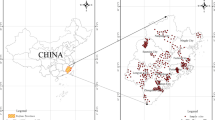Abstract
In this study, Arsenic (As) was measured in several varieties of imported and local cultivated rice. Soil samples collected from rice farms situated in south Caspian Sea (Iran) were also studied. The mean concentration of As in imported rice, local farmed rice and soil, were determined as 0.28, 0.39 and 3.80 μg g−1 dry weight, respectively. Estimated daily intake of As through human consumption of imported and local produced rice was 0.77 and 1.074 μg day−1 kg−1 B.W., respectively. These values are much lower than the tolerable daily intakes estimated by JECFA. The As concentration in the soil (3.80 μg g−1 dry) was below acceptable limit for agricultural soil of 20.0 mg kg−1 as recommended by the European Community (EC). No correlation between the As concentrations in rice and soil samples was found (p > 0.05).
Similar content being viewed by others
Notes
Joint FAO/WHO Expert Committee on Food Additives.
References
Abedin M, Cotter-Howells J, Meharg A (2002) Arsenic uptake and accumulation in rice (Oryza Sativa L.) irrigated with contaminated water. Plant Soil 240:311–319
Bhattacharya P, Samal A, Majumdar J, Santra S (2009) Accumulation of arsenic and its distribution in rice plant (Oryza sativa L.) in Gagetic West Bengal, India. Paddy Water Environ 8:63–70
Das HK, Mitra AK, Sengupta PK, Hossain A, Islam F, Rabbani GH (2004) Arsenic concentrations in rice, vegetables, and fish in Bangladesh: a preliminary study. Environ Int 30:383–387
Fu J, Zhou Q, Liu J, Liu W, Wang T, Zhang Q, Jiang G (2008) High levels of heavy metals in rice (Oryza sativa L.) from a typical E-waste recycling in southeast China and its potential risk to human health. Chemosphere 71:1269–1275
Lee H-S, Cho Y-H, Park S-O, Kye S-H, Kim B-H, Hahm T-S, Kim M, Lee JO, Kim C-i (2006) Dietary exposure of the Korean population to arsenic, cadmium, lead and mercury. Food Compost Anal 19:31–37
Lowik MRH (1996) Possible use of food composition surveys to estimate exposure to additives. Food Addit Contam 13:427–441
Munoz O, Bastias JM, Araya M, Morales A, Orellana C, Rebolledo R, Velez D (2005) Estimation of the dietary intake of cadmium, lead, mercuty, and arsenic by the population of Santiago (Chile) using a total diet study. Food Chem Toxicol 43:1647–1655
Rahman M (2002) Arsenic and contamination of drinking-water in Bangladesh: a public-health perspective. J Health Popul Nutr 20:193–197
Rahman MA, Hasegawa H, Mahfuzur Rahman M, Arifur Rahman M, Miah MAA (2007) Accumulation of arsenic in tissues of rice plant (Oryza Sativa L.) and its distribution in fractions of rice grain. Chemosphere 69:942–948
Rahman MA, Hasegawa H, Rahman M, Miah M, Tasmin A (2008) Arsenic accumulation in rice (Oryza sativa L.): human exposure through food chain. Ecotoxicol Environ Safe 69:317–324
Samadi-Maybodi A, Atashbozorg E (2006) Quantitative and qualitative of silica in different rice samples grown in north of Iran using UV-vis, XRD and IR spectroscopy techniques. Talanta 70:756–760
Sarkar B (2002) Heavy metals in the environment. Marcel dekker, New York
UNEP/FAO/WHO (1992) Assessment of dietary intake of chemical contaminants. United Nations Environmental Program, Nairobi
World Health Organization (WHO) (1993) Evaluation of certain food additives and contaminants (41st report of the joint FAO/WHO expert committee on food additives). WHO Tech. Reports Series No. 837.
Zhao K, Zhang W, Zhou L, Liu X, Xu J, Huang P (2009) Modeling transfer of heavy metals in soil-rice system and their risk assessment in paddy fields. Environ earth sci 9:519–527
Acknowledgment
We appreciate Tarbiat Modares University for financing this work and Ellen Vuosalo Tavakoli (university of Mazandaran) for editing of the English text.
Author information
Authors and Affiliations
Corresponding author
Rights and permissions
About this article
Cite this article
Rezaitabar, S., Esmaili-Sari, A. & Bahramifar, N. Potential Health Risk of Total Arsenic from Consumption of Farm Rice (Oryza sativa) from the Southern Caspian Sea Littoral and from Imported Rice in Iran. Bull Environ Contam Toxicol 88, 614–616 (2012). https://doi.org/10.1007/s00128-012-0537-7
Received:
Accepted:
Published:
Issue Date:
DOI: https://doi.org/10.1007/s00128-012-0537-7




